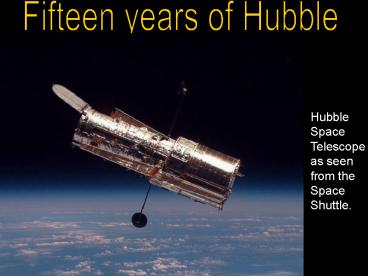Hubble Space Telescope as seen from the Space Shuttle' - PowerPoint PPT Presentation
1 / 25
Title:
Hubble Space Telescope as seen from the Space Shuttle'
Description:
The Crab Nebula is a six-light-year-wide expanding remnant of a star's supernova ... in September 2003, includes a yellow spiral whose arms have been stretched by a ... – PowerPoint PPT presentation
Number of Views:92
Avg rating:3.0/5.0
Title: Hubble Space Telescope as seen from the Space Shuttle'
1
Hubble Space Telescope as seen from the Space
Shuttle.
2
A galaxy has been discovered only ten million
light years away and has 100 million stars.
3
This is a NASA Hubble Space Telescope
ultraviolet-light image of the planet Venus,
taken on January 24, 1995, when Venus was at a
distance of 70.6 million miles from Earth. Venus
is covered with clouds made of sulfuric acid,
rather than the water- vapor clouds found on
Earth.
4
This portrait of Mars was taken on March 10.
1997, just before the Red Planet made one of its
closest passes to Earth about 60 million miles or
100 million kilometers.
5
On June 26, 2001, when Mars was approximately 43
million miles from Earth Hubble snapped this
picture. The colors have been carefully balanced
to gave a realistic view of Mars hues as they
might appear through a telescope.
6
This color image of Saturn was taken on August
26, 1990, when the planet was at a distance of
1.39 million kilometers (860 million miles) from
Earth.
7
The false-color image taken January 4, 1998
shows the planets reflected infrared light.
This view provides detailed information on the
clouds and hazes in Saturns atmosphere.
8
Here is a picture of Saturn taken by the Hubble
Telescope in ultraviolet light. The glowing
swirling material at Saturns poles is its
auroral curtains, rising more than a thousand
miles above the cloud tops.
9
This is the first true-color photograph of
Jupiter taken by the Hubble Telescope taken on
May 28, 1991.
10
These spots are actually a rare alignment of
three of Jupiters largest moons Io, Ganymede,
and Callisto across the planets face. In this
image, the telltale signatures of this alignment
are the shadows (the three black circles) cast by
the moons.
11
This ultraviolet image shows Jupiters atmosphere
after many impacts by fragments of comet
Shoemaker-Levy-9.
12
This spectacular color panorama of the center of
the Orion Nebula is one of the largest pictures
ever from individual images taken with the Hubble
telescope (1995).
13
This picture of the Keyhole Nebula was taken by
the Hubble Telescope in the year 2000.
14
NGC 1512 is a barred spiral galaxy located 30
million light-years away. The galaxy spans
70,000 light years, nearly as much as our galaxy.
This picture was taken on May 31, 2001.
15
Perhaps one of the most famous and easily
recognized space objects, the Eagle Nebula (also
known as Messier Object 16, M16 or NGC 6611) is a
young open cluster of stars. The release date
was November 2, 1995.
16
Giant galaxies werent assembled in a day.
Neither was this Hubble Space Telescope image.
17
The Crab Nebula is a six-light-year-wide
expanding remnant of a stars supernova
explosion. Japanese and Chinese astronomers
recorded this violent event nearly 1,000 years
ago in 1054, as did, almost certainly, Native
Americans.
18
Located an estimated 13 billion light-years away,
the object is being viewed at a time only 750
million years after the big bang, when the
universe was barely 5 percent of its current age.
19
Galaxy NGC 3949 is similar to our Milky Way.
This galaxy has a blue disk of young stars
peppered with bright pink star-birth regions.
The bright central bulge is made up of mostly
older, redder stars.
20
In 1995, the majestic spiral galaxy NGC 4414 was
imaged by the Hubble Space Telescope and is 60
million light years distant from our galaxy.
21
The Whirlpool galaxy, M51, has been one of the
most photogenic galaxies in amateur and
professional astronomy. Easily photographed and
viewed by smaller telescopes, this celestial
beauty is studied extensively.
22
The jumble of galaxies in this image, taken in
September 2003, includes a yellow spiral whose
arms have been stretched by a possible collision
lower right a young, blue galaxy top
bursting with star birth and several smaller,
red galaxies.
23
Two spiral galaxies pass by each other like
majestic ships in the night. Trapped in their
mutual orbit around each other, these two
galaxies will continue to distort and disrupt
each other.
24
This image is of an expanding halo of light
around a distant star, named V838 Monocerotis.
The illumination of interstellar dust comes from
the red supergiant star at the middle of the
image, which gave off a flashbulb-like pulse of
light.
25
Internet Resources
http//hubble.nasa.gov/index.php
http//hubble.nasa.gov/multimedia/astronomy.php
http//heritage.stsci.edu/gallery/gallery.html































